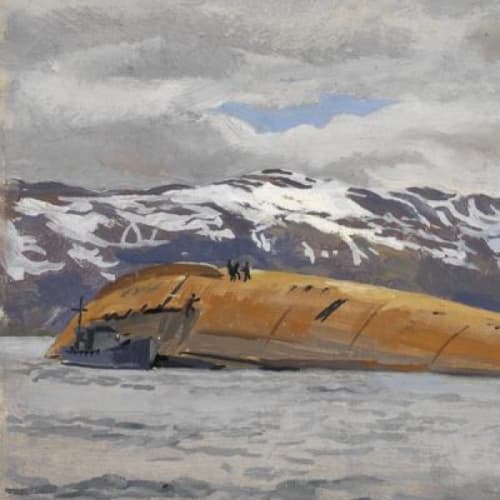Stephen Bone NEAC (13 November 1904 – 15 September 1958) was an English painter, writer, broadcaster and noted war artist. Bone achieved early success in book illustration using woodcuts before he turned to painting and art criticism. He was elected a member of the NEAC in 1932.
Early Life
Stephen Bone was born in Chiswick in west London, the son of Sir Muirhead Bone, an artist, and Gertrude Helena Dodd, a writer. After leaving Bedales School, he travelled widely in Europe with his father before enrolling at the Slade School of Fine Art in 1922. He became disillusioned with the Slade and left in 1924 to begin illustrating books, with woodcuts, for his mother and other writers.
In 1925, he was awarded the Gold Medal for Wood Engraving at the International Exhibition in Paris. In 1926, he was the subject of a joint exhibition at the Goupil Gallery, alongside Rodney Joseph Burn and Robin Guthrie, and in 1928 he painted a mural for the underground station at Piccadilly Circus.
In 1929, Bone married the artist Mary Adshead, and they were to have two sons and a daughter. The couple travelled extensively across Britain and Europe, which allowed Bone to paint outdoors in all weathers and to develop a style of bright landscape painting that proved popular and sold well at a number of gallery exhibitions.
During the 1930s, Bone exhibited at the Fine Art Society, at the Leferve Gallery, the Redfern Gallery and in 1936, exhibited a series of 41 paintings of British counties at the Ryman Gallery in Oxford. During 1936 and 1937 he painted and exhibited in Stockholm.
World War II
At the outbreak of the Second World War, Bone enlisted as an officer in the Civil Defence Camouflage Establishment based in Leamington Spa. In June 1943, Bone was appointed by the War Artists' Advisory Committee to be a full-time salaried artist to the Ministry of Information specialising in Admiralty subjects. The post had originally been held by Stephen's father, Muirhead Bone, but following the death of Gavin Bone, Stephen's brother, Muirhead decided not to continue with the commission.
Stephen produced many works around Great Britain, showing coastal installations and naval craft, including several works painted on-board submarines. He witnessed and sketched the 1944 Normandy landings, painted scenes in Caen and Courseulles after the invasion, and went on to record the assault on Walcheren Island in the Netherlands. Toward the end of 1945, he travelled to Norway and painted the wreck of the Tirpitz. In Norway, he also recorded captured naval bases and observed a number of mass graves of, mostly, Soviet prisoners of war.
Later life
After the War, Bone found his style of painting somewhat out of fashion and, although he continued to paint, he found it difficult to get his work exhibited. He became an art critic for the Manchester Guardian, wrote humorous pieces for the Glasgow Herald and did television and radio work for the BBC. With his wife, he wrote and illustrated children's books. Together they organised a mural painting course at Dartington. In 1957, Bone was appointed the director of the Hornsey College of Art. He died of cancer on 15 September 1958 at St Bartholomew's Hospital, London.
This is an edited version of Stephen Bone's Wikipedia biography.
You can also view a large collection of his artworks on his ArtUK website page.
Header image: Stephen Bone, 'The Wreck of the Tirpitz, June 1945' © IWM Art.IWM ART LD 5441
